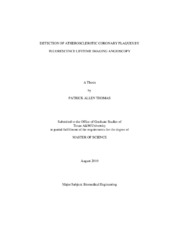| dc.description.abstract | Vulnerable plaque is a clinically silent condition of atherosclerotic plaque that leaves a large number of patients at risk of a coronary event. A method to detect vulnerable atherosclerotic plaque would greatly enhance the ability of clinicians to diagnose and treat patients at risk. Fluorescence lifetime imaging microscopy (FLIM) offers a way to extract both spatial and biochemical information from plaque by taking several wide-field images over time. The goal of this study was to determine the potential of a FLIM angioscopy system to detect and differentiate coronary atherosclerotic plaques ex-vivo into several groups including thin, fibrotic, lipid-laden, thick-cap fibroatheroma (FA), and fibrocalcified.
Samples were extracted post-mortem weekly and sliced open to have their lumens imaged. For each sample, 51 time resolved wide-field images were taken over 10 nanoseconds at 390 (±40) nm, 450 (±40) nm, and 550 (±88) nm wavelengths. To analyze the samples, the intensity map and lifetime map were created at each wavelength. The intensity map was simply the wide-field images summed in time and normalized. In order to calculate lifetime at each point, a fast, model-free Laguerre deconvolution algorithm was recently developed for FLIM data analysis and was used. This allowed for fast, efficient estimations of the fluorescence decay curves at each pixel of the FLIM images and facilitated the computation of quantitative parameters describing the fluorescence emission of the tissue, specifically, the relative fluorescence intensity and lifetime at defined emission bands.
Statistical analysis on these FLIM derived parameters indicated that the autofluorescence emission of the plaques allows for distinguishing relative plaque thickness: thin plaque, whose signal is dominated by elastin fluorophores, shows a marked difference between thicker plaques, such as fibrotic, fibrocalcified and thick-cap FA (who are dominated primarily by collagen). However, the ability of the current FLIM system to differentiate vulnerable plaque remains in question due to the absence of thin-cap FA samples. Further work has also been proposed; of primary concern is gathering thin-cap FA plaque samples needed to validate the system’s ability to differentiate vulnerable plaques from other common groupings. | en |


